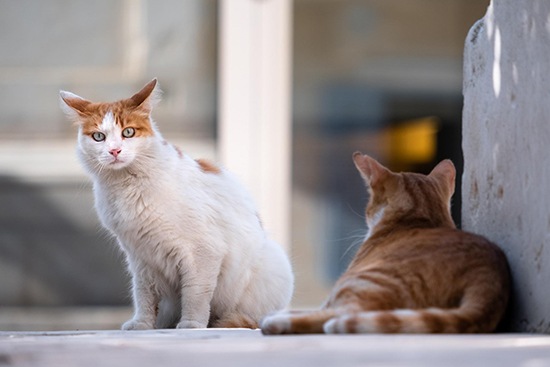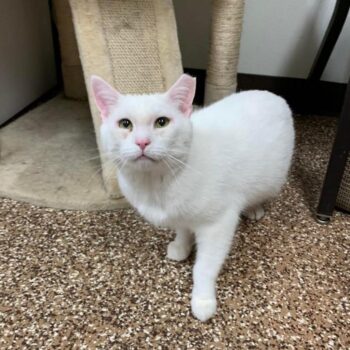Community Cats
HAVE YOU FOUND KITTENS?
Taking Them To The Shelter May Not Be The Best Thing For Them.
Mother cats are best equipped to provide care for kittens. Do not assume that the kittens are orphaned or abandoned just because you don’t see their mother. She may be out looking for food or hiding and waiting for you to leave. Kittens under six weeks of age should not be separated from their mothers if they appear healthy and are not injured.

Wait And Watch
Always wait several hours, or even a full day to see if a mother cat returns. Watch from a hidden spot or from inside so you don’t scare the mother cat away. Your presence may keep her from returning to her kittens’ nest.
Even if you don’t see the mother cat for a long time, check on the kittens periodically. If they are cuddled together and sleeping quietly, look pink, warm, and clean, and have full bellies, then their mother has very likely been back. You just didn’t notice. Community cats are good at staying out of sight when they want!
A Helpful Tip
Sprinkle flour near the kittens’ nest. If the mother cat returns, she will leave paw prints.
If you have waited for several hours or more than a day and have reason to believe the kittens’ mother is no longer around, step in to help them. Neonatal kittens (kittens 4 weeks old and younger) will need special supplies and round-the-clock care to survive.
What If The Kittens Are In Danger?
If a kitten is sick or injured, contact your local veterinarian right away if your kittens show these signs:
Signs of a sick kitten include:
- Thin stomachs and gaunt faces, visible ribs and spine
- Cold ears, bellies, and paws
- Pale gums and tongue
- Lethargy/almost no movement
- Excessively crusted eyes or nose
- Diarrhea or vomiting
- Struggling to breathe
Signs of an injured kitten include:
- Limping
- Visible wounds or sores
- Crying out in pain
There may be rare circumstances in which the kittens’ current environment places them in immediate danger. This is not a common scenario, so use common sense. For example, kittens may need to be removed if they are in an area that is about to be flooded or is close to a fire.
If possible, move the kittens to another outdoor spot as close to their original nest as is safe so their mother can find them.
If you believe mother and kittens are in more long-term danger, such as extreme weather or disaster conditions…
- Bring the whole family inside to a quiet, small room (like a bathroom). You can also use a large dog crate, covered with a blanket.
- Provide the mother cat and kittens with a carrier as a hiding place. Provide food and water, and a litter box placed as far away from the sleeping and eating area as possible.
What If Mom Doesn’t Return?
Determine how old they are by reviewing the Kitten Progression Chart.
Consider taking the kittens on as fosters before bringing them to SVASC. We took nearly 1,100 kittens into our care last year. We could not have all the positive outcomes for those kittens without the help of foster families. Ordinary families, just like yours, with whom we provided the resources and know how to help us save the little ones.
SVASC will provide you with any supplies you need and all the know-how to care for them. Young kittens cannot receive the attention and care they need in a shelter setting. By partnering with us to care for them we will together ensure the kittens get exactly what they need to get them ready for their adoptive homes. Please consider purchasing some of the supplies to help offset the cost of the full medical care that will be provided by the SVASC.

TRAP, NEUTER, RETURN (TNR)
WHAT IS TRAP, NEUTER, RETURN (TNR)?
In a nutshell: the most effective and humane approach to community cats. In more detail: colony caregivers and volunteers humanely trap community cats and bring them to a veterinary clinic, where they are spayed or neutered, vaccinated against rabies and distemper, ear-tipped, and given a basic checkup. After a 24-hour recovery period, the cats are returned to the exact location where they were initially trapped and released there. The cats can live out their lives in their outdoor home, but won't be adding to the community cat population. Sterilized community cats will no longer display those often-annoying behaviors associated with mating, such as yowling, fighting, spraying, and of course, producing kittens. Cats who go through a TNR program live healthier individual lives, and the community receives the added benefits of having these community cats vaccinated against rabies.

CAN’T COMMUNITY CATS JUST BE REMOVED OR RELOCATED?
No! Community cats live in an area because the resources - food, water, shelter - are there to support them. These resources may be provided by humans, or not. Rounding up the cats and bringing them to shelters (or rescues, or sanctuaries) does not solve the problem, plus the community cats will likely just be euthanized if they enter a shelter because they are not suited for life as an indoor pet cat. Relocation is also not a viable option. It is time-consuming and difficult, there is no guarantee that the cats will remain in the new location, and new locations for cats are very difficult to find. Removal or relocation efforts for community cats are not feasible.
HOW CAN I TELL IF A CAT HAS BEEN THROUGH A TNR PROGRAM?
If you see a community cat missing part of his or her left ear, that means the cat has been through a TNR program. This is called an 'eartip,' and an eartip is the universal signal that a cat has been spayed or neutered, and vaccinated against rabies and distemper. Community cats who have been through a TNR program are ear-tipped while they are under anesthesia for surgery, so if you see an ear-tipped cat - that means someone is looking out for that cat!

HOW DOES TNR BENEFIT THE COMMUNITY AND THE SHELTER?
Because community cats are not suited to life as an indoor pet cat, the only outcome for these cats who are brought to the shelter is euthanasia. Euthanizing an otherwise healthy cat for simply living outdoors is not the compassionate thing to do, nor is it effective in the long run. The most humane and effective approach for community cats is TNR because it stabilizes community cat populations which over time decline naturally. Sterilizing community cats reduces the nuisance behaviors (spraying, yowling, fighting) associated with mating, which makes cats better neighbors. TNR also saves taxpayer dollars by reducing the number of kittens who are brought to the Shelter in need of socialization, basic supplies and care, medical care, and adoptive homes. Having fewer kittens, and not accepting community cats overall into the shelter, allows us more time and resources to focus on the indoor pet cats who need our help and care to find them a new home!
If you have a group of feral cats in your area, please call us (540) 943-5142 or email our TNR specialist and we can tell you what to do next.

DID YOU KNOW...
An unspayed female cat, her mate, and all of their offspring, producing 2 litters a year with only 2.8 surviving kittens per litter can total:
- 1 year: 12
- 2 years: 67
- 3 years: 376
- 4 years: 2,107
- 5 years: 11,801
- 6 years: 66,088
- 7 years: 370,092
- 8 years: 2,072,514
- 9 years: 11,606,077
